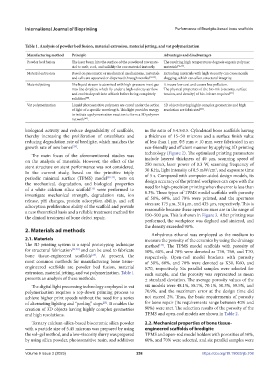Page 266 - IJB-9-3
P. 266
International Journal of Bioprinting Performance of Bredigite-based bone scaffolds
Table 1. Analysis of powder bed fusion, material extrusion, material jetting, and vat polymerization
Manufacturing method Principle Advantages and disadvantages
Powder bed fusion The laser beam hits the surface of the powdered raw mate- The resulting high temperatures degrade organic polymer
rial to melt, cool, and solidify the raw material instantly. materials [36,37] .
Material extrusion Based on pneumatic or mechanical mechanisms, materials Extruding materials with high viscosity can cause nozzle
and cells are squeezed or dispensed through nozzles [38,39] . clogging, which can affect structural integrity.
Material jetting The liquid stream is atomized with high-pressure inert gas It incurs low cost and causes less pollution.
into fine droplets, which fly under a high-velocity air flow The physical properties of the bio-ink (viscosity, surface
and cool to deposit into a blank before being completely tension, and density) of bio-ink are required .
[41]
solidified .
[40]
Vat polymerization Liquid photosensitive polymers are cured under the action 3D objects having highly complex geometries and high
of light of a specific wavelength. This light provides energy resolution are fabricated .
[43]
to initiate a polymerization reaction to form a 3D polymer
network .
[42]
biological activity and reduce degradability of scaffolds, in the ratio of 5:4.5:0.5. Cylindrical bone scaffolds having
thereby increasing the proliferation of osteoblasts and a thickness of 15–50 microns and a surface finish value
reducing degradation rate of bredigite, which matches the of less than 1 μm Φ5 mm × 10 mm were fabricated in an
growth rate of new bones . eco-friendly and efficient manner by applying 3D printing
[29]
technology (Figure 2). The optimized printing parameters
The main focus of the aforementioned studies was
on the analysis of materials. However, the effect of the include layered thickness of 40 μm, scanning speed of
250 mm/s, laser power of 0.3 W, scanning frequency of
stent structure on stent performance was not considered. 30 KHz, light intensity of 8.5 mW/cm , and exposure time
2
In the current study, based on the primitive triply of 5 s. Compared with computer-aided design models, its
periodic minimal surface (TPMS) model [30-32] , tests on design accuracy of the printed workpiece can cope with the
the mechanical, degradation, and biological properties need for high-precision printing when the error is less than
of a white calcium silica scaffold were performed to 0.3%. Three types of TPMS model scaffolds with porosity
[33]
investigate mechanical strength, degradation rate, ion of 50%, 60%, and 70% were printed, and the apertures
release, pH changes, protein adsorption ability, and cell sizes are 175 μm, 310 μm, and 435 μm, respectively. This is
adsorption proliferation ability of the scaffold and provide reasonable because these aperture sizes are in the range of
a new theoretical basis and a reliable treatment method for 150–500 μm. This is shown in Figure 3. After printing was
the clinical treatment of bone defect repair.
performed, the workpiece was deglued and sintered, and
the density exceeded 98%.
2. Materials ad methods
Anhydrous ethanol was employed as the medium to
2.1. Materials measure the porosity of the ceramics by using the drainage
The 3D printing system is a rapid prototyping technique method . The TPMS model scaffolds with porosity of
[44]
for structural fabrication [34,35] and can be used to fabricate 50%, 60%, and 70% were denoted as T50, T60, and T70,
bone tissue-engineered scaffolds . At present, the respectively. Open-rod model brackets with porosity
[25]
most common methods for manufacturing bone tissue- of 50%, 60%, and 70% were denoted as K50, K60, and
engineered scaffolds are powder bed fusion, material K70, respectively. Six parallel samples were selected for
extrusion, material jetting, and vat polymerization. Table 1 each sample, and the porosity was represented as mean
presents an analysis of these methods. ± standard deviation. The average porosity values of the
The digital light processing technology employed in vat six models were 48.1%, 58.7%, 70.1%, 50.3%, 59.5%, and
polymerization requires a top-down printing process to 70.9%, and the maximum error at the design time did
achieve higher print speeds without the need for a series not exceed 2%. Thus, the basic requirements of porosity
of alternating lighting and “peeling” steps . It enables the for bone repair (its requirements range between 40% and
[25]
creation of 3D objects having highly complex geometries 90%) were met. The selection results of the porosity of the
and high resolutions. TPMS and open-rod models are shown in Table 2.
Ternary calcium-silica-based bioceramic silica powder 2.2. Mechanical properties of bone tissue-
with a particle size of 5.45 microns was prepared by using engineered scaffolds of bredigite
the sol–gel method, and a low-viscosity slurry was prepared TPMS and open-rod model holders with porosities of 50%,
by using silica powder, photosensitive resin, and additives 60%, and 70% were selected, and six parallel samples were
Volume 9 Issue 3 (2023) 258 https://doi.org/10.18063/ijb.708

